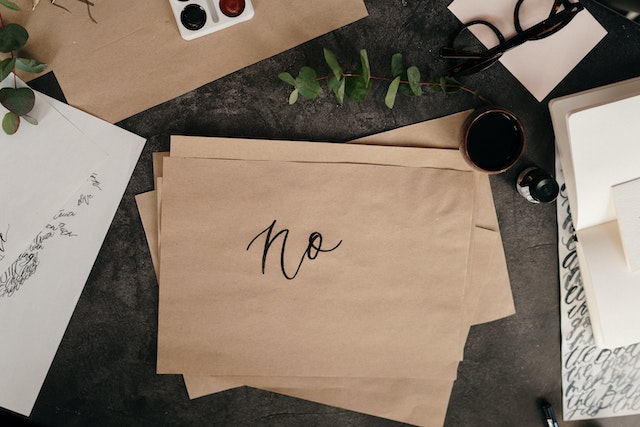How To Break Codependency | 10 Tips Break Free From Codependency
“Self-care is not selfish, it’s an act of self-love.”
If you’re wondering how to break codependency, I don’t blame you. Being an ex-codependent myself, I know that it’s exhausting always trying to please everyone else but yourself. Even though you feel drained out, you’re struggling to break your codependency habits and you’re wondering if there’s a way out of it.
It takes time and commitment to change, and in the beginning, it will feel uncomfortable and at times threatening. Yet pushing past this phase will help you break codependency and create a life that is more aligned with what makes you happy and fulfilled.
In this guide, I’ll share with you 10 powerful tips that helped me break codependency in relationships. Not only was I able to build healthier relationships with romantic partners and friends, but I also developed a healthier and fulfilling relationship with myself.
10 Tips on How to Break Codependency
#1. Become aware of your codependent habits
The first step to break codependency is becoming aware of your behaviors and catching yourself doing it. Codependent habits are automatic behaviors due to your need for approval and validation from others to feel loved, valued, worthy, and appreciated.
Being aware of your codependency habits gives you the power to break free from automatic behaviors. Through conscious behavioral changes and life choices, you’ll learn how to break codependency and free yourself from the compulsive need to please others.
Here’s a list of common codependent habits and behaviors to help you become aware of them.
Do you recognize any of these codependent behaviors in your relationships?
- Sacrifice your needs and emotions to please others
- You feel responsible for other people’s emotions
- Cancel your plans to accommodate your partner
- No matter what you do, you never feel good enough
- Find it difficult to communicate your needs and feelings
- You struggle to set boundaries and to be assertive
- Feel overwhelmed with guilt and shame when you don’t please others
- Not knowing what you really like or what you’re passionate about
- Lacking a sense of purpose and fulfillment in your life
- Seeking purpose in serving and pleasing others
- You fear abandonment in relationships
- You struggle to adapt to change and feel anxious
When you catch yourself engaging in these kinds of compulsive behaviors, remind yourself that your needs and emotions matter. You don’t need to please others to be loved. Being who you are is good enough.
Related: Am I enough?
#2. Be curious about who you really are
A common trait in codependent people (including my past self) is not knowing who they are, what they like, or what they truly care about. They just care about pleasing others. Being consumed by the need to please others doesn’t leave you any time and energy to get to know who you are.
Codependents tend to lose themselves in relationships as they become entirely focused on their partners’ needs. To break codependency in a relationship, you need to find balance between fulfilling your partner’s needs and yours. Your needs and your feelings are as important and valid as your partners’.
You might be scared that this will jeopardize your relationship because through your past experiences you’ve learned that to save a relationship, or to receive love, you must ignore your feelings and needs to please others. This creates a power imbalance in the relationship and leaves you feeling exhausted.
If you want to learn how to break codependency in a relationship, improving your relationship dynamics is essential. Start dedicating at least 30 minutes with yourself without any distractions, without a phone, or anything to disturb you.
This will give you time to get in touch with yourself. A nice warm bath, with scented candles or incense, relaxing music and a book is a great way to start! If you’re not a fan of warm baths, go for a run or take a mindful walk in nature.
Related: What is fear of abandonment? | How to overcome fear of abandonment
#3. Communicate your needs to break codependency
Before I learned how to break codependency, I had no idea how to communicate my needs. Even the thought of it would make me anxious. When I started to practice communicating my needs to break my codependency habits, I used to have panic attacks. But it became easier the more I practiced it.
Change is uncomfortable. You’re going against your subconscious program that has been driving you to engage in this compulsive codependent behavior that leaves you feeling empty and exhausted.
As I worked on myself to break free from codependency, I realized that no matter how hard I tried, I was never going to feel good enough. I accepted the fact that I could never feel whole and complete as long as I continued my codependent behaviors.
So I started slowly communicating my needs with people I trusted. Even though I knew they weren’t going to be upset with me, it still felt unnatural. Until it didn’t any longer and it became my natural state, my new way of being, and living.
Learning how to communicate your needs gives you instant relief and a sense of freedom. Here are some ways you can start practicing communicating your needs to break codependency:
- When someone asks you for your opinion, don’t reply with “I don’t mind”, or “whatever you want is fine for me”. Make up your mind, make a choice, and say it out loud.
- If you’re invited to an event which you’re not really interested in, don’t say yes so you avoid upsetting your friend. Explain how you feel about it and state the truth. Be true to yourself.
- When someone asks for your help or for a favor and you can’t do it, don’t cancel your plans or sacrifice yourself to help them. Take care of yourself first and let them know that unfortunately you are unable to help them this time. Remember, you can’t give to others from an empty cup.
#4. Take yourself out on dates

Sounds scary right?! Trust me, it took me years to build up the courage to take myself out on dates. At first, I was very self-conscious. I was telling myself that others will look at me and judge me for being alone at a table.
The desire to break codependency was bigger than the fear of other peoples’ judgements. So I put on my best outfit and I took myself out on a dinner date. Surprisingly enough, it was really enjoyable and I started doing it on a weekly basis.
I chose a nice restaurant with a beautiful view so I don’t get tempted to stay on my phone. And I decided to spoil myself with a nice dinner. At first I felt a bit anxious, but I looked around me and I noticed that everyone was busy minding their own business.
The food came and I enjoyed the delicious meal as I gazed at the sunset over the horizon feeling proud of myself. My first self-date was an accomplishment, a milestone that played an imported role in my journey to break free from codependency.
This became a weekly habit and I started to look forward to this sacred time for myself. I invite you to try it out for yourself. If your mind starts playing with you and telling you that others will laugh at you, ignore that silly thought.
Go out, hold your head high, be confident and enjoy your time with yourself. Don’t spend the whole time on your phone! The point is to be with yourself and get to know yourself. I mean can you imagine how rude it would be if you went out on a date with someone and stayed on your phone?
Ideas for self-dates:
- Coffee date or brunch
- Nice dinner at a good restaurant
- Picnic in the park / nature
- Reading a book by the beach
- Mindful walk in nature
Related: What’s The Difference Between Codependency VS Love
#5. Break codependency habits by setting boundaries

During one of my coaching sessions, I asked one of my clients to define the term ‘boundaries’. She looked at me with confusion and she was surprised with herself because she couldn’t verbalize what boundaries actually are.
Boundaries are a way to protect yourself from being taken advantage of. Codependents may see boundaries as a threat to their relationships because they fear communicating their needs and emotions. Through past experiences, as a codependent you’ve been exposed to people who responded negatively to you when you communicated your needs.
So you end up seeing boundaries as a trigger to conflict. You feel like if you set boundaries you will be rejected or abandoned. And of course these experiences are very painful, even for adults let alone for children.
If you want to break codependency, learning how to set boundaries is essential. By time, you’ll learn that setting solid boundaries is safe and is no longer a threat to your relationships, unless you’re in a toxic relationship.
To practice setting boundaries, first you need to be aware of your:
- Values
- Tolerances
- Needs
- Feelings
When something doesn’t feel right for you, it’s okay to express yourself and communicate how you feel to others. This applies for both romantic relationships, friendships, and also at work.
For example, let’s say your manager at work gives you a task with an unrealistic deadline, it’s okay to explain that you would need more time to complete the task to provide high quality work.
If your friend is always complaining about personal issues and taking advantage of your kindness and willingness to help, it’s okay to refuse helping out when it’s inconvenient for you.
#6. Journal your thoughts and emotions

Journaling is a powerful practice that allows you to develop a healthier relationship with yourself. To break codependency and find out who you really are, it requires self-reflection and introspection. Starting journaling as a habit is a great way to get in touch with your thoughts and emotions.
So how do you journal? Write in your journal as if you were speaking to a best friend. Keep your journal in a safe space to feel safe putting down your thoughts and feelings. Write down in your journal at least once a month. At the end of each month, write down a summary of what happened that month and how you feel about it.
If you feel the need to write more, even better! When you feel overwhelmed with thoughts or emotions, it’s also a great time to journal. Writing down your thoughts and feelings helps you declutter your mind and you feel a sense of relief as you put them down on paper.
When you feel triggered or you feel anxious due to a specific situation or circumstances, become aware of how you’re feeling and ask yourself questions to understand yourself at a deeper level so you can write down why you’re feeling this way.
I’ve been practicing journaling for years. And it really helped me understand myself better and it gives me a sense of relief from the overwhelming thoughts and feelings that sometimes get triggered. As you progress and transform into a better version of yourself, it’s also interesting to read chapters from the past and see how much you’ve grown!
#7. Go beyond your limits to break free from codependency

Back in the days when I struggled with codependency in relationships, I was fully dependent on my partner. I felt powerless, and I was scared to do anything by myself.
Throughout my journey of self-discovery, I proved myself wrong. Everything that I thought I was incapable of doing was actually a limiting belief. My limitations were a result of the stories I told myself, and my past experiences which shaped who I was.
Just like me, most people underestimate their own capabilities. The truth is that as you start getting to know yourself, you’ll soon realize that you’re capable of more than you ever imagined. This realization not only boosts your self-confidence, but it empowers you to try new things and go beyond your limits.
Going beyond your limits will seem challenging and scary. But that’s when you know that you’re growing and expanding yourself to new possibilities.
When I started challenging myself, I transformed from a codependent victim of domestic violence, to a self-made entrepreneur traveling freely around the world as a digital nomad.
If someone had to tell me years ago how my life would change, I would have laughed in disbelief. And I know that the same powerful transformation is possible for you too.
#8. Find out what sets your soul on fire
When I used to sit for interviews and get asked questions about my personality I used to freeze and get filled with anxiety. A simple question like “Tell us more about yourself, what do you enjoy doing?” would give me a panic attack.
I had no idea how to answer those questions because I didn’t know what I enjoyed doing. To break my codependency habits, I realized that I needed to figure out what I actually liked. Otherwise, I kept finding myself trying to help others and avoiding being with myself.
Being of service to others was the perfect way to distract myself from my own unresolved wounds that needed healing. Don’t get me wrong, helping and serving others is fulfilling. But not when it’s used as a way to validate yourself or when it’s compulsive. Neglecting yourself to help others is toxic, not fulfilling.
The fact that I didn’t know what I liked made me feel even more panicked. I felt bad about myself and I avoided finding the answers. I didn’t really know where to start. So I just started trying out new things to find out what I liked.
It was easier to start by eliminating what I didn’t like. I told myself that it’s okay to try new things and find out that I didn’t like them. At first it was frustrating, but then I realized that it was only bringing me closer to what I actually enjoyed doing.
I tried 10 different jobs in 8 different industries. I didn’t stop until I found what actually sets my soul on fire. Once you find your passions and purpose, no matter what happens in life, you’ll always feel like you’re walking in the right direction.
Related: Can’t find my passion in life | Living a life or purpose
#9. Ask for help and support to break codependency
Learning how to break free from codependency can be challenging. Surrounding yourself with people who support you throughout this journey of transformation is a great way to lift up your spirits.
It’s okay to feel scared and challenged at times, it’s part of being human. Most importantly is that you don’t get stuck in that state of being. Being surrounded by a good support system that makes you feel comforted empowers you to keep moving forward. There are several support groups which you can join either locally or online.
When you share your experiences, emotions, and challenges with others who are going through the same journey, you don’t feel like you’re going through it alone. And this is really encouraging, it always helps to be a part of a community who you can resonate with.
#10. Change your attachment style to break free from codependency
Once I was talking to my therapist about my relationship drama. I was so tired of it and I was exhausted from feeling anxious all the time trying to control everything. She told me that I seemed to have an anxious avoidant attachment style or a disorganized attachment style. So she suggested that we do a test to find out.
I had never heard this term before, so I asked her to explain more. Learning about attachment theory really helped me understand why I was always attracted to toxic people who were emotionally unavailable.
Your attachment style determines how you behave in relationships. Codependent behavior is related to anxious and avoidant attachment styles. So it’s important to become aware of your attachment style as this will help you make sense of your behavior.
As you understand yourself at a deeper level and why you behave in a certain way, it will be easier to break codependency in a relationship. Changing your attachment style liberates you from compulsive and impulsive behavior triggered by anxiety and fear.
So how do you change your attachment style?
This goes hand in hand with changing your behavior to break codependency habits. The following steps will help you change your attachment style and break codependency:
- Repeat codependency affirmations
- Improve the relationship with yourself
- Work on your self-esteem and self-worth
- Heal past wounds from childhood
- Do not engage in toxic relationships
- Learn how to feel whole and complete by yourself
- Enjoy spending time with yourself
FAQ
These 10 tips teach you how to break codependency:
1.Become aware of your codependency habits
2.Be curious about who you are
3.Communicate your needs
4.Take yourself out on dates
5.Learn how to set boundaries
6.Journaling
7.Go beyond your limits
8.Find out your passions
9.Ask for help and support
10.Change your attachment style
Codependency is triggered by feelings of unworthiness and the need to please others. It is generally the result of past childhood experiences where a child learns that communicating their own needs and emotions causes drama, conflict, rejection or abandonment. As an adult you end up never feeling good enough and develop people pleasing habits.
These are some of the common signs of a codependent person:
-Need to please others
-Neglecting own needs and feelings
-Unable to set boundaries
-Struggle to say no to others
-Never feeling good enough
-Seeking validation from others
Related Articles:
When The Narcissist Dumps The Codependent
When A Codependent Leaves A Narcissist
Codependency Triangle In Narcissistic Relationships
How To Stop Being Codependent With A Narcissist






